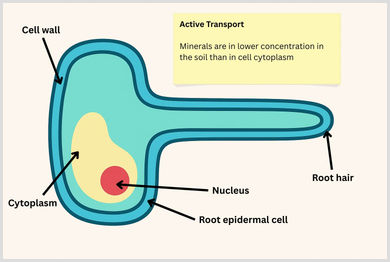Cell transport is crucial to the survival of every living organism. Substances need to move in and out of cells, such as oxygen entering your bloodstream, or plants absorbing nutrients from the soil. Cells are constantly moving particles to maintain bodily function.
This article will explore the three main types of cell transport: diffusion, osmosis, and active transport. There are rules and purposes for each type. They combine to keep cells alive, stable, and efficient.
This article is suitable for GCSE Biology revision. If you need further support preparing for this topic, TeachTutti has qualified GCSE Biology tutors who can teach you in person or virtually, using the TeachTutti learning platform.
Cell transport
Cell transport is when substances move in and out of cells. Useful substances are taken in, such as oxygen, water and glucose, while waste is removed, e.g. carbon dioxide. Organisms rely on this process for their cells to be healthy and carry out reactions.
The substances move in or out of cells according to differences in concentration. This means how crowded a particular particle is in different areas. If one cell has many particles and another has fewer, the particles will move to even the concentrations. This rule is followed for two types of cell transport.
The cell membrane is a boundary around the cell. It controls what enters and leaves. Small substances can pass across the membrane easily, while others need energy to cross. The movement type, requiring energy or not, depends on the substance and the situation of the cell.
The three types of cell transport are diffusion, osmosis, and active transport. They feature in GCSE Biology, often with diagrams of graph-based questions.
1
What is the purpose of cell transport?
Simple diffusion
Diffusion means the movement of particles because there is an imbalance: there is more in one area than in the other. It doesn't need any energy for this to occur and is crucial to keep cells alive and working properly. For example:
- Oxygen diffuses into cells when there is more oxygen outside the cell than inside
- Carbon dioxide diffuses because it is created in the cells during respiration
The speed of diffusion across a membrane depends on the temperature, the distance, and whether there is a notable higher concentration in an area of lower concentration. If it is warmer, the particles have more energy and will move faster. The movement is more noticeable when there is a larger concentration difference inside and outside the cells. The process is also faster when the distances are shorter, which is why cells are so small.

Facilitated diffusion
There is another type of diffusion known as facilitated diffusion. The idea is the same in that particles diffuse across a cell membrane from an area of high concentration to an area of lower concentration. No energy is used to diffuse into the cell.
The difference is that some particles are too large or have too much energy to pass through the membrane. They need to move through special protein channels instead, which essentially are doorways to help the particle cross safely into the cell.
This knowledge is required for A Level Biology, not GCSE. It shows that cell membranes are not just barriers: they have greater control over what enters and leaves the cell than diffusion alone suggests.
2
Which of the following best describes diffusion?
Osmosis
Osmosis is diffusion that happens when water moves across a partially permeable membrane. Put another way, the membrane allows certain molecules to pass through, but blocks others. In this case, water can cross the cell membrane because there are gaps that water molecules are small enough to pass through. Larger particles are blocked, such as sugars or salts.
Water converts from a dilute solution to being more concentrated. There is a lot of water outside the cell, and it becomes more solute in the cell, where there is less water. It is a passive process, and no energy is used during osmosis.
It is a crucial process as it controls the amount of water inside the cells of living organisms. Too much water can cause a cell to burst. Too little water may shrink the cell. It is used by plants for turgor pressure, which keeps their stems firm and stops them from wilting. Similarly, animal cells would fail to maintain a stable internal environment without osmosis.

3
How does water move during osmosis?
Active transport across membranes
Active transport is when a cell moves particles from a low concentration to a high concentration. It needs to use energy, because it's the opposite direction to diffusion. This energy is normally from respiration, where special proteins inside the membrane act like pumps. They take particles and push them where they are needed in the cell.
This process is crucial for living organisms. Without it, they can't control internal conditions or collect the substances they need to survive, such as nutrients and oxygen:
- Plants - The root hair cells use active transport to absorb nutrients from the soil, even when there are fewer mineral ions than there are inside the root cell
- Animals - The small intestine uses active transport to absorb the remaining glucose from food, which is used in the body as energy
The diagram below shows a root hair cell, which absorbs mineral ions from the soil. It has a long, thin extension to help the plant take in the maximum number of nutrients. There are more minerals in the cytoplasm than in the soil outside. The cell has to use active transport, as diffusion can't move particles from a low concentration to a high one. The proteins in the cell use energy from respiration to take minerals into the cell against the concentration gradient. This lets the plant absorb ions even if the soil has few nutrients.

The image below shows the lumen of the small intestine. After the glucose has largely been absorbed by diffusion, the remaining amount in the lumen is taken into the intestinal cells by active transport. The downward arrow shows the glucose being moved from a low concentration outside the cell into an area that already has a high concentration. Going against the gradient requires energy from respiration, letting the cell absorb as much glucose as possible, which then passes into the bloodstream to be used as energy.

In your GCSE Biology exam, you may see diagrams that show particles being pushed into a crowded area. Remember, the key feature of active transport is movement against the concentration gradient and the need for energy.
4
What is active transport?
Comparing diffusion, osmosis and active transport
Transport in cells is vital to keep organisms alive. Diffusion, osmosis and active transport allow cells to take in and remove solutions through the membrane. These processes give cells glucose for respiration, let plants absorb minerals from the soil, and allow your nerve cells to pass signals around your body. Even simple actions like breathing and moving rely on the movement of molecules across cell membranes.
The list below shows the differences between the three main types of transport across cell membranes:
| Process | Definition | Substances | Energy needed |
| Diffusion | Substances move from a higher concentration to a lower concentration | Oxygen, water, food substances, and waste, including carbon dioxide and urea (carbamide) | No |
| Osmosis | Water passes through a partially permeable membrane that admits small molecules across the membrane. It goes from high concentration to low concentration | Water | No |
| Active transport | Substances move from a low concentration to a concentrated gradient | Plants - Mineral ions into the roots Animal - Glucose from the gut into intestinal cells, from where it moves into the blood | Yes |
Conclusion - Transport across the cell membrane
Cell transport involves passing materials across the cell membrane, such as removing waste and taking in nutrients, such as oxygen. Transport processes are essential for maintaining the life and function of living organisms. Without diffusion, osmosis, and active transport, cells won't receive what they need, waste will accumulate in cells, and life will break down.
This article has explored how each type of transport works and the key differences. For further reading, you can read the BBC Bitesize article explaining the cell membrane in greater detail. You can also read an overview of cell processes on Wikipedia.
If you need personalised support, TeachTutti has top Biology GCSE tutors. Every tutor has an enhanced DBS check and can teach you online or in person. They will tailor lessons to your specific needs, such as preparing revision notes.

